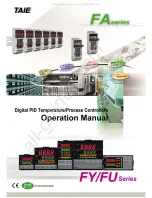
For stepper motor operation, an encoder is optional.
For servo motor operation, if you have a preferred definition of the forward and reverse
directions, make sure that the encoder wiring is consistent with that definition.
The DMC-2x00 accepts single-ended or differential encoder feedback with or without an
index pulse. If you are not using the ICM-2900 you will need to consult the appendix for the
encoder pinouts for connection to the motion controller. The ICM-2900 accepts encoder
feedback via individual signal leads. Simply match the leads from the encoder you are using
to the encoder feedback inputs on the interconnect board. The signal leads are labeled CHA
(channel A), CHB (channel B), and INDEX. For differential encoders, the complement
signals are labeled CHA-, CHB-, and INDEX-.
NOTE:
When using pulse and direction encoders, the pulse signal is connected to CHA and the
direction signal is connected to CHB. The controller must be configured for pulse and direction
with the command CE. See the command summary for further information on the command CE.
Step D.
Verify proper encoder operation.
Start with the A encoder first. Once it is connected, turn the motor shaft and interrogate the
position with the instruction TPA <return>. The controller response will vary as the motor is
turned.
At this point, if TPA does not vary with encoder rotation, there are three possibilities:
1.
The encoder connections are incorrect - check the wiring as necessary.
2.
The encoder has failed - using an oscilloscope, observe the encoder signals. Verify
that both channels A and B have a peak magnitude between 5 and 12 volts. Note
that if only one encoder channel fails, the position reporting varies by one count
only. If the encoder failed, replace the encoder. If you cannot observe the encoder
signals, try a different encoder.
3.
There is a hardware failure in the controller - connect the same encoder to a different
axis. If the problem disappears, you probably have a hardware failure. Consult the
factory for help.
Step E.
Connect Hall Sensors if available.
Hall sensors are only used with sinusoidal commutation and are not necessary for proper
operation. The use of Hall sensors allows the controller to automatically estimate the
commutation phase upon reset and also provides the controller the ability to set a more precise
commutation phase. Without Hall sensors, the commutation phase must be determined
manually.
The Hall effect sensors are connected to the digital inputs of the controller. These inputs can
be used with the general use inputs (bits 1-8), the auxiliary encoder inputs (bits 81-96), or the
extended I/O inputs of the DMC-2x00 controller (bits 17-80).
NOTE:
The general use inputs are optoisolated and require a voltage connection at the INCOM
point - for more information regarding the digital inputs, see Chapter 3, Connecting Hardware.
Each set of sensors must use inputs that are in consecutive order. The input lines are specified
with the command, BI. For example, if the Hall sensors of the C axis are connected to inputs
6, 7 and 8, use the instruction:
BI ,, 6 or
BIC
=
6
DMC-2X00
Chapter 2 Getting Started
y
23
Summary of Contents for DMC-2010
Page 18: ...THIS PAGE LEFT BLANK INTENTIONALLY 8 Chapter 1 Overview DMC 2X00...
Page 48: ...THIS PAGE LEFT BLANK INTENTIONALLY 38 Chapter 2 Getting Started DMC 2X00...
Page 78: ...THIS PAGE LEFT BLANK INTENTIONALLY 68 Chapter 5 Command Basics DMC 2X00...
Page 180: ...THIS PAGE LEFT BLANK INTENTIONALLY 170 Chapter 7 Application Programming DMC 2X00...
Page 215: ...Dimensions for DMC 2x00 DMC 2X00 Appendices y 205...
















































